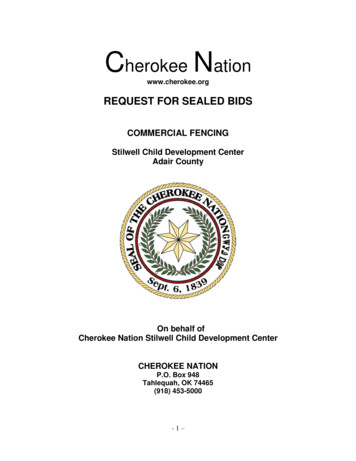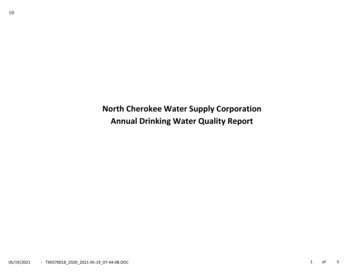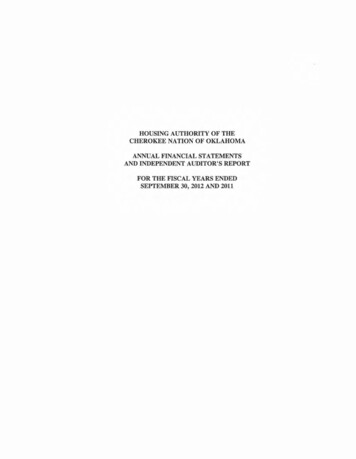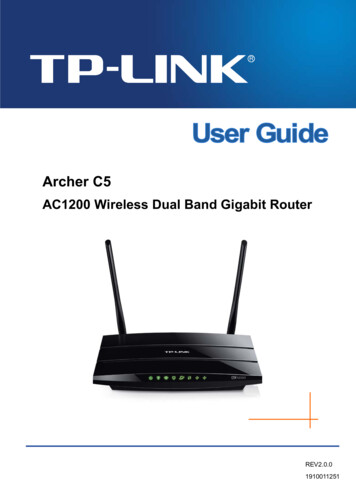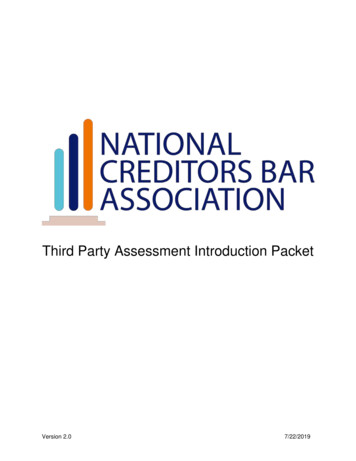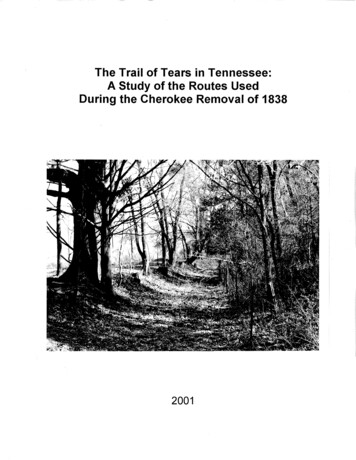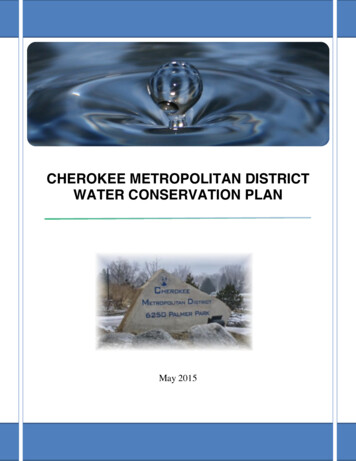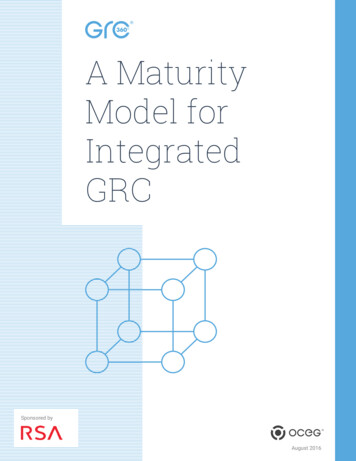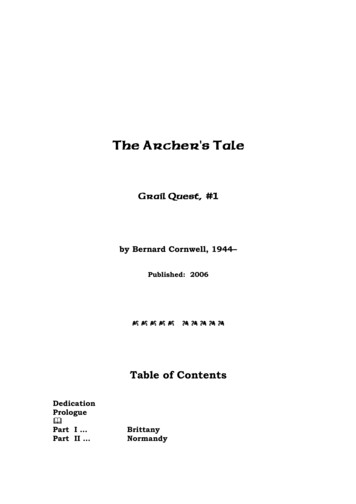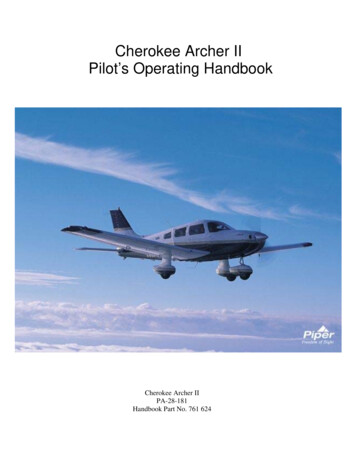
Transcription
Cherokee Archer IIPilot’s Operating HandbookCherokee Archer IIPA-28-181Handbook Part No. 761 624
Piper Aircraft CorporationPA-28-181, Cherokee Archer IINew Piper AircraftAndThe Notre Dame Pilot InitiativePartners in Aviation EducationNot to be used for flight planning purposes. Data may be inaccurate or out of date.Not an actual Pilot’s Operating Handbook or Airplane Flight Manual.Copyedited by Miss Elizabeth O’Shaughnessy August 2003Minor typographical corrections (Revision C) by Brian K. Wade, April 2004Published exclusively for the Notre Dame Pilot Initiative August 2003Copyrighted by Piper Aircraft Corporation April 19792
Piper Aircraft CorporationPA-28-181, Cherokee Archer IITable of ContentsSECTION 1 – GENERAL . 51.11.21.31.41.51.61.71.81.9INTRODUCTION . 5ENGINES . 7PROPELLERS. 7FUEL . 7OIL. 7MAXIMUM WEIGHTS. 8STANDARD AIRPLANE WEIGHTS. 8BAGGAGE SPACE . 8SPECIFIC LOADINGS. 8SECTION 2 – LIMITATIONS . 92.12.22.32.42.52.62.72.82.9INTRODUCTION . 9AIRSPEED LIMITATIONS . 9AIRSPEED INDICATOR MARKINGS. 9POWER PLANT LIMITATIONS. 10CENTER OF GRAVITY LIMITS . 10MANEUVER LIMITS . 11FLIGHT LOAD FACTORS . 11TYPES OF OPERATION . 11FUEL LIMITATIONS. 11SECTION 3 – EMERGENCY PROCEDURES . 123.1 INTRODUCTION . 123.2 EMERGENCY CHECKLISTS . 123.3 AMPLIFIED EMERGENCY PROCEDURES (GENERAL). 143.4 ENGINE FIRE DURING START. 143.5 ENGINE POWER LOSS DURING TAKEOFF . 143.6 ENGINE POWER LOSS IN FLIGHT . 153.7 POWER OFF LANDING. 153.8 FIRE IN FLIGHT . 163.9 LOSS OF OIL PRESSURE . 163.10 LOSS OF FUEL PRESSURE. 173.11 HIGH OIL TEMPERATURE. 173.12 ALTERNATOR FAILURE. 173.13 SPIN RECOVERY . 173.14 OPEN DOOR. 183.15 CARBURETOR ICING . 183.16 ENGINE ROUGHNESS . 18SECTION 4 – NORMAL PROCEDURES. 194.14.24.34.44.54.64.7INTRODUCTION . 19AIRSPEEDS FOR SAFE OPERATIONS. 19NORMAL PROCEDURES CHECK LIST . 20AMPLIFIED NORMAL PROCEDURES (GENERAL) . 23PREFLIGHT CHECK . 23BEFORE STARTING ENGINE . 24STARTING ENGINE. 253
Piper Aircraft CorporationPA-28-181, Cherokee Archer II4.8 WARM-UP . 264.9 TAXIING. 264.10 GROUND CHECK. 264.11 BEFORE TAKEOFF . 274.12 TAKEOFF . 274.13 CLIMB. 284.14 CRUISING . 284.15 DESCENT . 284.16 APPROACH AND LANDING . 294.17 STOPPING ENGINE . 294.18 PARKING. 304.19 STALLS. 304.20 TURBULENT AIR OPERATION . 304.21 WEIGHT AND BALANCE . 30SECTION 5 – PERFORMANCE . 315.1 INTRODUCTION TO PERFORMANCE & FLIGHT PLANNING . 315.2 FLAPS UP TAKEOFF PERFORMANCE. 325.3 25 deg FLAPS TAKEOFF PERFORMANCE . 335.4 TIME, DISTANCE, & FUEL TO CLIMB. 345.5 ENGINE PERFORMANCE. 355.6 SPEED POWER – PERFORMANCE CRUISE . 365.7 SPEED POWER – ECONOMY CRUISE. 375.8 BEST POWER MIXTURE RANGE. 385.9 BEST ECONOMY MIXTURE RANGE . 395.10 ENDURANCE. 405.11 GLIDE RANGE. 415.12 LANDING PERFORMANCE. 42SECTION 6 – WEIGHT AND BALANCE. 436.1 INTRODUCTION . 436.2 WEIGHT AND BALANCE LOADING FORM . 436.3 C.G. RANGE AND WEIGHT. 44SECTION 7 – AIRPLANE & SYSTEM DESCRIPTIONS . 457.1 THE AIRPLANE. 457.2 AIRFRAME. 457.3 ENGINE AND PROPELLER . 457.4 LANDING GEAR . 457.5 FLIGHT CONTROL CONSOLE. 467.6 FLIGHT CONTROLS . 467.7 ENGINE CONTROLS . 477.8 FUEL SYSTEM. 477.9 ELECTRICAL SYSTEM . 497.10 VACUUM SYSTEM. 517.11 INSTRUMENT PANEL. 517.12 PITOT-STATIC SYSTEM. 527.13 HEATING AND VENTILATING SYSTEM . 537.14 CABIN FEATURES. 537.15 BAGGAGE AREA. 534
Piper Aircraft CorporationPA-28-181, Cherokee Archer II7.167.177.187.19STALL WARNING. 54FINISH . 54PIPER EXTERNAL POWER . 54EMERGENCY LOCATOR TRANSMITTER. 54SECTION 8 – HANDLING, SERVICE, & MAINTENANCE . 56SECTION 9 – SUPPLEMENTS . 56SECTION 1 – GENERAL1.1 INTRODUCTIONThis Pilot’s Operating Handbook is designed for maximum utilization as an operating guide forthe pilot. It includes the material required to be furnished to the pilot by C.A.R. 3 and FAR Part21, Subpart J. It also contains supplemental data supplied by the airplane manufacturer.This handbook is not designed as a substitute for adequate and competent flight instruction,knowledge of current airworthiness directives, applicable federal air regulations or advisorycirculars. It is not intended to be a guide for basic flight instruction or a training manual andshould not be used for operational purposes unless kept in a current status.Assurance that the airplane is in an airworthy condition is the responsibility of the owner. Thepilot in command is responsible for determining that the airplane is safe for flight. The pilot isalso responsible for remaining within the operating limitations as outlined by instrumentmarkings, placards, and this handbook.Although the arrangement of this handbook is intended to increase its in-flight capabilities, itshould not be used solely as an occasional operating reference. The pilot should study the entirehandbook to familiarize himself with the limitations, performance, procedures, and operationalhandling characteristics of the airplane before flight.The handbook has been divided into numbered (Arabic) sections, each provided with a “fingertip” tab divider for quick reference. The limitations and emergency procedures have beenplaced ahead of the normal procedures, performance, and other sections to provide easier accessto information that may be required in flight. The “Emergency Procedures” section has beenfurnished with a red tab divider to present an instant reference to the section. Provisions forexpansion of the handbook have been made by the deliberate omission of certain paragraphnumbers, figure numbers, item numbers, and pages noted as being left blank intentionally.5
Piper Aircraft CorporationPA-28-181, Cherokee Archer IIFigure 1: Three Way View6
Piper Aircraft CorporationPA-28-181, Cherokee Archer II1.2 ENGINES1.3 PROPELLERS(a) Number of Engines1(b) Engine ManufacturerLycoming(c) Engine Model NumberO-360A4A(d) Rated Horsepower180(e) Rated Speed (rpm)2700(f) Bore (inches)5.125(g) Stroke (inches)4.375(h) Displacement (cubic inches) 361(i) Compression Ratio8.5:1(j) Engine Type 4 Cylinder, HorizontallyOpposed, Direct Drive,Air Cooled(a) Number of Propellers(b) Propeller Manufacturer(c) Model76EM8S5-0-60(d) Number of Blades(e) Propeller Diameter (inches)(f) Propeller TypePitch276Fixed1.4 FUEL(a) Fuel Capacity (U.S. gal.)(b) Usable Fuel, Total(c) Fuel Grade, Aviation(1) Minimum Octane(2) Specified Octane1.5 OIL(a) Oil Capacity (U.S. Quarts) 8(b) Oil Specification15W-50(c) Oil Viscosity per Average Ambient Temp. for StartingMIL-L-6082BMineralSAE Grade(1)(2)(3)(4)(5)(6)(7)1SensenichAll Temperatures-Above 80 degress F60Above 60 degrees F5030 degrees to 90 degrees F400 degrees to 70 degrees F300 degrees to 90 degrees F 20W-50Below 10 degrees F20MIL-L-22851Ashless DispersantSAE Grades15W-50 OR 20W-506040 or 504030. 40, or 20W-4020W-50 or 15W-5030 or 20W-30When operating temperatures overlap indicated ranges, use the lighter grade oil.75048100/130100LL
Piper Aircraft CorporationPA-28-181, Cherokee Archer II1.6 MAXIMUM WEIGHTSNORMAL(a) Maximum Takeoff Weight (lbs)(b) Maximum Landing Weight (lbs)(c) Maximum Weights in Baggage Compartment25502550200UTILITY2130213001.7 STANDARD AIRPLANE WEIGHTS(a) Standard Empty Weight (lbs): Weight of astandard airplane including unusable fuel,full operating fluids and full oil(b) Maximum Useful Load (lbs): The differencebetween the Maximum Takeoff Weight andthe Standard Empty Weight141611341.8 BAGGAGE SPACE(a) Compartment Volume (cubic feet)(b) Entry Width (inches)(c) Entry Height (inches)2422201.9 SPECIFIC LOADINGS(a) Wing Loading (lbs per sq ft)(b) Power Loading (lbs per hp)15.014.28
Piper Aircraft CorporationPA-28-181, Cherokee Archer IISECTION 2 – LIMITATIONS2.1 INTRODUCTIONThis section provides the “FAA Approved” operating limitations, instrument markings, color coding andbasic placards necessary for the operation of the airplane and its systems.This airplane must be operated as a normal of utility category airplane in compliance with the operatinglimitations stated in the form of placards and markings and those given in this section and this completehandbook.Limitations associated with those optional systems and equipment which require handbook supplementscan be found in Section 9 (Supplements).2.2 AIRSPEED LIMITATIONSSPEEDKIASKCASNever Exceed Speed (VNE) – Do not exceed thisspeed in any operation.154148Maximum Structural Cruising Speed (VNO) – Donot exceed this speed except in smooth air and thenonly with caution1251211138911189Design Maneuvering Speed (VA) – Do not make fullor abrupt control movements above this speedAt 2550 LBS. G.W.At 1634 LBS. G.W.CautionManeuvering speed decreases at lighter weight as the effects ofaerodynamic forces become more pronounced. Linear interpolationmay be used for intermediate gross weights. Maneuvering speed shouldnot be exceeded while operating in rough air.Maximum Flaps Extended Speed (VFE) – Do notexceed this speed with the flaps extended.1021002.3 AIRSPEED INDICATOR MARKINGSMARKINGIASRed Radial Line (Never Exceed)Yellow Arc (Caution Range – Smooth Air Only)Greed Arc (Normal Operating Range)White Arc (Flap Down)(154 KTS)(125 to 154 KTS)(55 to 125 KTS)(49 to 102 KTS)9
Piper Aircraft CorporationPA-28-181, Cherokee Archer II2.4 POWER PLANT LIMITATIONS(a) Number of Engines(b) Engine Manufacturer(c) Engine Model No.(d) Engine Operating Limits(1) Maximum Horsepower(2) Maximum Rotation Speed (RPM)(3) Maximum Oil Temperature(e) Oil PressureMinimum (red line)Maximum (red line)(f) Fuel PressureMinimum (red line)Maximum (red line)(g) Fuel Grade (AVGAS ONLY) (minimum octane)(h) Number of Propellers(i) Propeller Manufacturer(j) Propeller Model(k) Propeller DiameterMinimumMaximum(l) Propeller Tolerance (static RPM at maximumPermissible throttle setting)1Lycoming0360-A4A1802700245 deg F25 PSI90 PSI.5 PSI8 PSI100/130 - Green1Sensenich76EM8S5-0-6076 inches76 inchesNot below 2325 RPMNot above 2425 RPM2.5 CENTER OF GRAVITY LIMITS(a) Normal CategoryWeightPounds25502050(b) Utility CategoryWeightPounds20502130Forward LimitInches Aft of Datum88.682.0Forward LimitInches Aft of Datum82.083.0Rearward LimitInches Aft of Datum93.093.0Rearward LimitInches Aft of Datum93.093.0NOTESStraight line variation between points given. The datum used is 78.4 inches ahead of the wing leadingedge at the inboard intersection of the straight and tapered section. It is the responsibility of the airplaneowner and the pilot to ensure that the airplane is properly loaded. See Section 6 (Weight and Balance) forproper loading instructions.10
Piper Aircraft CorporationPA-28-181, Cherokee Archer II2.6 MANEUVER LIMITS(a) Normal Category – All acrobatic maneuvers including spins prohibited.(b) Utility Category – Approved maneuvers for bank angles exceeding 60 degrees.Entry Speed113 KIAS113 KIAS113 KIASSteep TurnsLazy EightsChandelles2.7 FLIGHT LOAD FACTORSNORMALUTILITY3.8 G4.4 GNo inverted maneuvers approved(a) Positive Load Factor (Maximum)(b) Negative Load Factor (Maximum)2.8 TYPES OF OPERATIONThe airplane is approved for the following operations when equipped in accordance with FAR 91 or FAR135.(a) Day V.F.R.(b) Night V.F.R.(c) Day I.F.R.(d) Night I.F.R.(e) Non Icing2.9 FUEL LIMITATIONS(a) Total Capacity(b) Unusable FuelThe unusable fuel for this airplane has been determinedas 1.0 gallon in each wing in critical flight attitudes.(c) Usable FuelThe usable fuel in this airplane has been determined as24.0 gallons in each wing.1150 U.S. GAL2 U.S. GAL48 U.S. GAL
Piper Aircraft CorporationPA-28-181, Cherokee Archer IISECTION 3 – EMERGENCY PROCEDURES3.1 INTRODUCTIONThis section contains procedures that are recommended if an emergency condition should occur duringground operation, takeoff, or in flight. These procedures are suggested as the best course of action forcoping with the particular condition described, but are not a substitute for sound judgment andcommon sense. Since emergencies rarely happen in modern aircraft, their occurrence is usuallyunexpected, and the best corrective action may not always be obvious. Pilots should familiarizethemselves with the procedures given in this section and be prepared to take appropriate action shouldan emergency arise.Most basic emergency procedures, such as power off landings, are a normal part of pilot training.Although these emergencies are discussed here, this information is not intended to replace suchtraining, but only to provide a source of reference and review, and to provide information onprocedures that are not the same for all aircraft. It is suggested that the pilot review standardemergency procedures periodically to remain proficient in them.3.2 EMERGENCY CHECKLISTSENGINE POWER LOSS IN FLIGHTFuel selector .tank containing fuelElectric fuel pump .ONMixture .check RICHCarburetor heat .ONEngine gauges .check for indicationof cause of pwr lossPrimer .check lockedIf no fuel pressure is indicated, check tank selectorposition is on a tank containing fuel.ENGINE FIRE DURING STARTStarter .crank engineMixture idle cut-offThrottle openElectric fuel pump .OFFFuel selector .OFFAbandon if fire continuesENGINE POWER LOSS DURINGTAKEOFFIf sufficient runaway remains for anormal landing, land straight ahead.When power is restored:Carburetor heat . .OFFElectric fuel pump . OFFIf power is not restored, prepare power offlanding.Trim for 76 KIASIf insufficient runaway remains:Maintain safe airspeedMake shallow turns to avoid obstructionsFlaps as situation requiresIf sufficient altitude to attempt a restart:Maintain safe airspeedFuel selector .tank containing fuelElectric fuel pump check ONMixture check RICHCarburetor heat ONPrimer .lockedIf still no power, plan power off landing12
Piper Aircraft CorporationPA-28-181, Cherokee Archer IIALTERNATOR FAILUREVerify failureReduce electrical load as much as possible.Alternator circuit breakers .checkAlt switch .OFF 1 second then onIf no output:Alt switch . OFFReduce electrical load and land as practical.POWER OFF LANDINGLocate suitable field.Establish spiral pattern1000 ft. above field at downwind positionfor normal landing approach.When field can easily be reached,slow to 66 KIAS for shortest landing.Touchdowns should normally be made atlowest possible airspeed with full flaps.SPIN RECOVERYThrottle .idleAilerons .neutralRudder full opposite todirection of rotationControl wheel .full forwardRudder neutral whenrotation stopsControl wheel .smoothly regainlevel flight altitudeWhen committed to landing:Ignition OFFMaster switch .OFFFuel selector OFFMixture idle cut-offSeat belt and harness tightFIRE IN FLIGHTSource of fire .checkElectrical fire (smoke in cabin):Master switch OFFVents .openCabin heat .OFFLand as soon as practicable.OPEN DOORSlow airplane to 87 KIASCabin vents closeStorm window openIf upper latch is open .latchIf side latch is open pull on armrest whilemoving latch handle to latched positionIf both latches are open .side latch, then topEngine fire:Fuel selector .OFFThrottle .ClosedMixture .idle cut-offElectric fuel pump check OFFHeater and defroster .OFFProceed with power off landing procedure.CARBURETOR ICINGCarburetor Heat .ONMixture .max. smoothnessENGINE ROUGHNESSCarburetor heat ONIf roughness continues after one min:Carburetor heat . .OFFMixture . .max smoothnessElectric fuel pump .ONFuel selector .switch tanksEngine gauges checkMagneto switch .”L”&“R” then BOTHIf operation is satisfactory on either one, continueon that magneto at reduced power and full “RICH”mixture to first airport. Prepare for power offlandingHIGH OIL TEMPERATURELand at nearest airport and investigate theproblem.Prepare for a power off landing.LOSS OF OIL PRESSURELand as soon as possible and investigate cause.Prepare for power off landing.LOSS OF FUEL PRESSUREElectric fuel pump .ONFuel selector .check on full tank13
Piper Aircraft CorporationPA-28-181, Cherokee Archer II3.3 AMPLIFIED EMERGENCY PROCEDURES (GENERAL)The following paragraphs are presented to supply additional information for the purpose of providing thepilot with a more complete understanding of the recommended course of action and probable cause of anemergency situation.3.4 ENGINE FIRE DURING STARTEngine fires during start are usually the result of overpriming. The first attempt to extinguish the fire is totry to start the engine and draw the excess fuel back into the induction system.If a fire is present before the engine has started, move the mixture control to idle cut-off, open the throttleand crank the engine. This is an attempt to draw the fire back into the engine.If the engine has started, continue operating to try to pull the fire into the engine.In either case (above), if fire continues more than a few seconds, the fire should be extinguished by thebest available external means. The fuel selector valves should be “OFF” and the mixture at idle cut-off ifan external fire extinguishing method is to be used.3.5 ENGINE POWER LOSS DURING TAKEOFFThe proper action to be taken if loss of power occurs during takeoff will depend on the circumstances ofthe particular situation.If sufficient runway remains to complete a normal landing, land straight ahead.If insufficient runway remains, maintain a safe airspeed and make only a shallow turn if necessary toavoid obstructions. Use of flaps depends on the circumstances. Normally, flaps should be fully extendedfor touchdown.If sufficient altitude has been gained to attempt a restart, maintain a safe airspeed and switch the fuelselector to another tank containing fuel. Check the electric fuel pump to ensure that it is “ON” and thatthe mixture is “RICH.” The carburetor heat should be “ON” and the primer checked to ensure that it islocked.If engine failure was caused by fuel exhaustion, power will not be regained after switching fuel tanks untilthe empty fuel lines are filled. This may require up to ten seconds.If power is not regained, proceed with the Power Off Landing procedure (refer to the emergency check listand paragraph 3.7).14
Piper Aircraft CorporationPA-28-181, Cherokee Archer II3.6 ENGINE POWER LOSS IN FLIGHTComplete engine power loss is usually caused by fuel flow interruption and power will be restored shortlyafter fuel flow is restored. If power loss occurs at a low altitude, the first step is to prepare for anemergency landing (refer to paragraph 3.13). An airspeed of at least 76 KIAS should be maintained.If altitude permits, switch the fuel selector to another tank containing fuel and turn the electric fuel pump“ON.” Move the mixture control to “RICH” and the carburetor heat to “ON.” Check the engine gaugesfor an indication of the cause of power loss. Check the engine gauges for an indication of the cause of thepower loss. Check to ensure the primer is locked. If no fuel pressure is indicated, check the tank selectorposition to be sure it is on a tank containing fuel.When power is restored move the carburetor heat to the “OFF” position and turn “OFF” the electric fuelpump.If the preceding steps do not restore power, prepare for an emergency landing.If time permits, turn the ignition switch to “L” then to “R” then back to “BOTH.” Move the throttle andmixture control levers to different settings. This may restore power if the problem is too rich or too lean amixture or if there is a partial fuel system restriction. Try other fuel tanks. Water in the fuel could takesome time to be used up, and allowing the engine to windmill may restore power. If power is due towater, fuel pressure indications will be normal.If engine failure was caused by fuel exhaustion power will not be restored after switching fuel tanks untilthe empty fuel lines are filled. This may require up to ten seconds.If power is not regained, proceed with the Power Off Landing procedure (refer to the emergency check listand paragraph 3.13).3.7 POWER OFF LANDINGIf loss of power occurs at altitude, trim the aircraft for best gliding angle 76 KIAS (Air Cond. Off) andlook for a suitable field. If measures taken to restore power are not effective, and if time permits, checkyour charts for airports in the immediate vicinity: it may be possible to land at one if you have sufficientaltitude. If possible, notify the FAA by radio of your difficulty and intentions. If another pilot orpassenger is aboard, let him help.When you have located a suitable field, establish a spiral pattern around this field. Try to be at 1000 feetabove the field at the downwind position, to make a normal landing approach. When the field can easilybe reached, slow to 66 KIAS with flaps down for the shortest landing. Excess altitude may be lost bywidening your pattern, using flaps or slipping, or a combination of these.Touchdown should normally be made at the lowest possible airspeed. When committed to a landing,close the throttle control and shut “OFF” the master and ignition switches. Flaps may be used as desired.Turn the fuel selector valve to “OFF” and move the mixture to idle cut-off. The seat belts and shoulderharness (if installed) should be tightened. Touchdown should be normally m
Not an actual Pilot's Operating Handbook or Airplane Flight Manual. Copyedited by Miss Elizabeth O'Shaughnessy August 2003 Minor typographical corrections (Revision C) by Brian K. Wade, April 2004 Published exclusively for the Notre Dame Pilot Initiative August 2003
